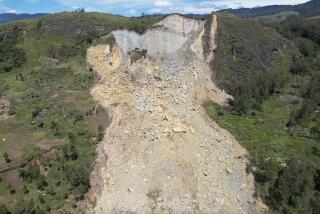Tapping Sounds Raise Hopes, Briefly
- Share via
GUINSAUGON, Philippines — Buoyed by the sound of repeated tapping from deep beneath the mud, rescue crews continued to dig their way through more than 20 feet of mud to a buried school in hope of finding survivors three days after a massive landslide crushed this remote village.
But rescuers, including U.S. Marines, who worked into the evening found only more dead bodies Monday, dashing hopes of finding the first survivors since 20 people were pulled from the mud Friday.
The remote village of Guinsaugon on Leyte island was home to more than 1,800 people before it was obliterated by millions of tons of mud that poured down from a mountainside soaked by more than 24 inches of rain since Feb. 1.
Authorities are uncertain how many people were crushed by the mud, but estimates range from 900 to 1,400. More than 1,000 rescuers, including teams from Malaysia, Taiwan and Spain, have been battling the odds in the hope of finding survivors.
Bunny Hermanos, who has been searching since Saturday, indicated how desperate the rescue effort had become as he set off early today to resume digging. “I hope we find even a roof,” he said. “It will give us hope.”
On Monday, teams using sound equipment reported hearing scratching noises and rhythmic tapping near what had been the site of a school where about 250 students and teachers were in class at the time of the mudslide.
Members of the international rescue effort interpreted the sounds as signs of life and redoubled their efforts. Some of the Marines thought they might have heard voices from under the mud.
“We know there’s something down there,” Marine Lt. Richard Neikirk said. “The farther down we went, the signals grew stronger.”
Southern Leyte province Gov. Rosette Lerias, who has been overseeing the rescue effort, was elated by the first good news in days.
“First we heard scratches,” she said. “Now it’s rhythmic tapping. It cannot be just a rat making those sounds. It’s enough that we heard a sound of life. Hallelujah! Praise God!”
At one point Monday evening, a top government official announced on national television that 50 survivors had been found at the school. But the report quickly proved untrue.
Efforts have focused on the school because a relative of a trapped teacher reported receiving cellphone messages. But the last text message was received before dawn Saturday.
The mud initially was too soft to allow the use of heavy equipment, but by Monday crews were able to use earthmovers in some areas. Still, hundreds of rescuers resorted to picks and shovels and used crowbars and ropes to move boulders out of the way. They bailed water using plastic containers. In some places, the mud was 100 feet deep.
International rescue teams used dogs, seismic detectors and heat sensors as well as the audio equipment to search for signs of life. Instead, they found 13 bodies, bringing the total number of confirmed dead to at least 84.
Gov. Lerias said she had no plans to abandon the rescue effort. “It is our job to find these people,” she said. “And if God wills it, we will find them.”
About 11 p.m. Monday, rescue operations were suspended for the night because of renewed rainfall and a flow of mud that officials worried could endanger rescuers.
The decision disappointed relatives of the missing.
At the rescuers’ base camp a mile from Guinsaugon, Bebot Pagaura held a small photo of his son, Anthony, 10, who was at school when the landslide hit. The 30-year-old farmer said he had hoped rescuers would bring in more heavy equipment and work through the night.
“Even if hundreds of volunteers dig, it could take a long time before they reach my son,” he said.
“He could still be alive right now. I don’t know if he will be dead by the time they reach him. Every minute counts.”
Times staff writer Paddock reported from Singapore and special correspondent Santos from Guinsaugon. Special correspondent Sol Vanzi in Manila also contributed to this report.
More to Read
Sign up for Essential California
The most important California stories and recommendations in your inbox every morning.
You may occasionally receive promotional content from the Los Angeles Times.













